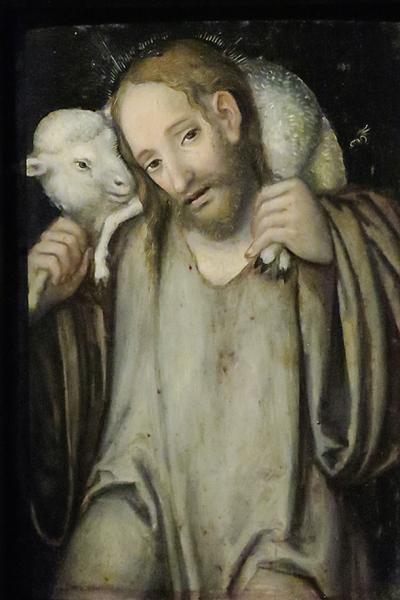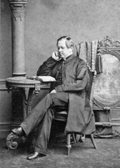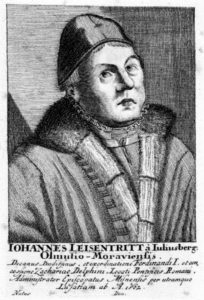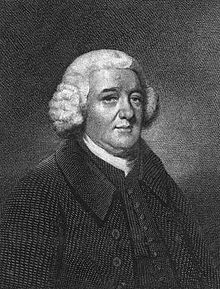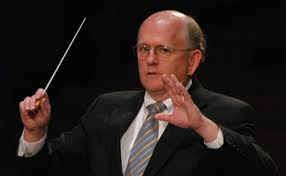The Good Shepherd, Louis Cranach the Younger
Mount Calvary Church
Eutaw Street and Madison Acenue
Baltimore, Maryland
A Roman Catholic Parish of
The Personal Ordinariate of the Chair of St. Peter
Anglican Use
Rev. Albert Scharbach, Pastor
Easter IV
April 22, 2018
_______________
Prelude
Erschienen ist der herrliche Tag, J. S. Bach
Hymns
The King of love my shepherd is (ST COLUMBA)
Be joyful, Mary, heavenly Queen (REGINA COELI)
I know that my Redeemer lives (DUKE ST)
Anthems
My shepherd will supply my need, arr. Mack Wilberg
Ego sum pastor bonus, Giovanni Bonaventura Matucci (1712-1777)
Common
Missa S. Maria Magdelena, Healey Willan
Postlude
Christ ist erstanden, J. S. Bach
________________________________
Hymns
The King of love my shepherd is (ST COLUMBA)
Henry Williams Baker (1821-1877) recast George Herbert’s metrical paraphrase of Psalm 23 into this hymn, The King of love my shepherd is. Baker gives Psalm 23 an explicit Christological and sacramental cast. “The streams of living water” flow from Jesus’ pierced side. He ransoms our soul from the captivity of sin, and feeds with food celestial, “the bread which cometh down from heaven, that a man may eat thereof, and not die” On our own we never keep to the righteous paths. That is why Jesus comes in love to us, sinners as we are. In his persistent and tender mercy Jesus seeks us, when, “perverse and foolish,” we stray from Him. The wood of the shepherd’s staff is the wood of the cross that guides the strayed soul. Delights flow from Jesus’ pure chalice. The “wine that gladdens the heart” is the Eucharist, the blood of Christ; His is the chalice that overbrims with love. In the Old Testament, our ancestors in faith longed to dwell in the “house of the Lord,” before the revelation of eternal life was clear. But now Christ fulfills that mysterious longing. He is the Good Shepherd, who “giveth his life for the sheep,” the ultimate gift, eternal life with Him. (Thanks to Tony Esolen)
Here is a Reformed analysis of the hymn:
“We note immediately that the usual way of naming God (“the Lord”) has been replaced with a nonbiblical yet immediately comprehensible allegorical title, “the King of Love.” This unfamiliar opening and the inversion in the first line (“my shepherd is”) prepare the singer for a text that is intentionally—even self-consciously—allusive and aesthetic. This perception of the text is reinforced by the archaic verb forms (“leadeth,” “feedeth”) and the Latinate diction (“verdant,” “celestial”) in the second stanza. The third stanza intensifies the Christological overtones of this paraphrase with allusions not only to the Good Shepherd passage noted earlier but also to Jesus’ parable of the Lost Sheep (Luke 15:4-7; cf. Matthew 18:12-14). The fourth stanza follows the biblical shift from third person to second person, but adds to the images of the shepherd’s rod and staff the suggestion of a processional cross familiar to many nineteen-century Anglican congregations. There is a similar churchy slant in the fifth stanza, where the psalter’s “oil” takes on sacramental tones by being called “unction,” and the usual English translation “cup” becomes a comparably Latinate and ecclesiastical “chalice.” As a result, the reference to God’s “house” in the final line of the sixth stanza does not suggest the Temple in Jerusalem so much as it does the church building in which the hymn is being sung.” (ReformedWorship.org)
I doubt that in the last line “Thy house” is simply the church building; heaven is clearly meant and specified by the “forever.” Anglocatholic services are long, but not that long.
1 The King of love my shepherd is,
whose goodness faileth never.
I nothing lack if I am his,
and he is mine forever.
2 Where streams of living water flow,
my ransomed soul he leadeth;
and where the verdant pastures grow,
with food celestial feedeth.
3 Perverse and foolish, oft I strayed,
but yet in love he sought me;
and on his shoulder gently laid,
and home, rejoicing, brought me.
4 In death’s dark vale I fear no ill,
with thee, dear Lord, beside me;
thy rod and staff my comfort still,
thy cross before to guide me.
5 Thou spreadst a table in my sight;
thy unction grace bestoweth;
and oh, what transport of delight
from thy pure chalice floweth!
6 And so through all the length of days,
thy goodness faileth never;
Good Shepherd, may I sing thy praise
within thy house forever.
Here is the Cardiff Festival Choir singing the hymn. Here is John Rutter’s lovely arrangement with harp accompaniment.
Henry Williams Baker
Sir Henry Williams Baker was the eldest son of Admiral Sir Henry Loraine Baker. Henry was born in London, May 27, 1821, and educated at Trinity College, Cambridge, where he graduated, B.A. 1844, M.A. 1847. Taking Holy Orders in 1844, he became, in 1851, Vicar of Monkland, Herefordshire. This benefice he held to his death, on Monday, Feb. 12, 1877. He succeeded to the Baronetcy in 1851. His hymns, including metrical litanies and translations, number in the revised edition of Hymns Ancient & Modern, 33 in all. The last audible words which lingered on his dying lips were the third stanza of his rendering of the 23rd Psalm, “The King of Love, my Shepherd is:”—
Perverse and foolish, oft I strayed,
but yet in love he sought me;
and on his shoulder gently laid,
and home, rejoicing, brought me.
This tender sadness, brightened by a soft calm peace, was an epitome of his poetical life.
The tune is St. Columba. Because the compilers of the 1906 English Hymnal were denied permission to use Dykes’s original tune (see sidebar, below), musical editor Ralph Vaughan Williams (1872-1958) turned to a folk tune that his former teacher Charles Villiers Stanford (1852-1924) had recently edited for a collection of Irish music (A Complete Collection of Irish Music as noted by George Petri (London, 1902-1905); ST. COLUMBA is no. 1043). The two most notable improvements Vaughan Williams made in the hymn tune known as ST. COLUMBA were the lengthening of the second and fourth lines to extend the Common Meter tune to 8787 in order to accommodate Baker’s text—this being their first appearance together—and the use of a triplet (rather than an eighth and two sixteenths) in the sixth measure. (ReformedWorship.org).
____________________________
Be joyful, Mary, heavenly Queen
Be joyful Mary, heavenly Queen is a translation of Regina coeli, iubila, an anonymous 17th century hymn. The tune was written by Johann Leisentritt (1527-1586), and published in his Catholicum Hymnologium Germanicum in 1584. Here is Notre Dame.
The words in the 1901 translation (Psallite: English Catholic Hymns) closely follow the Regina coeli. The words have been modernized in out version. I am searching for the original translation.
1 Be joyful, Mary, heav’nly Queen,
Gaude, Maria!
Your grief is changed to joy serene,
Alleluia! Laetare, O Maria!2 The Son you bore by heaven’s grace,
Gaude, Maria!
Did by his death our guilt erase,
Alleluia! Laetare, O Maria!
3 The Lord has risen from the dead,
be joyful, Mary!Gaude, Maria!
He rose in glory as he said,
Alleluia! Laetare, O Maria!4 Then pray to God, O Virgin fair,
be joyful, Mary!Gaude, Maria!
That he our souls to heaven bear,
Alleluia! Laetare, O Maria!
Here is the Notre Dame choir singing it as a recessional.
The Latin original is somewhat different:
Regina coeli jubila, Gaude Maria.
Jam pulsa cedunt nubila.
Alleluia. Laetare o Maria.2. Quem digna terris gignere, Gaude Maria.
Vivis resurgit funere.
Alleluia. Laetare o Maria.3. Sunt fracta mortis spicula, Gaude Maria.
Jesu jacet mors subdita.
Alleluia. Laetare o Maria.4. Acerbitas solatium, Gaude Maria.
Luctus redonat gaudium.
Alleluia. Laetare o Maria.5. Turbata sputis lumina, Gaude Maria.
Phoebea vincunt fulgura,
Alleluia. Laetare o Maria.6. Manum pedumque vulnera, Gaude Maria.
Sunt gratiarum flumina,
Alleluia. Laetare o Maria.7. Transversa ligni robora, Gaude Maria.
Sunt sceptra regni fulgida.
Alleluia. Laetare o Maria.8. Lucet arundo purpura, Gaude Maria.
Ut fulva terrae viscera,
Alleluia. Laetare o Maria..9. Catena, clavi, lancea, Gaude Maria.
Triumphi sunt insignia,
Alleluia. Laetare o Maria..10. Ergo, Maria, plaudito, Gaude Maria.
Clientibus succurrito,
Alleluia. Laetare o Maria.
Here is Praetorius’s setting.
______________________________
I know that my Redeemer lives (DUKE ST)
I know that my redeemer lives is by the English Baptist Samuel Medley (1738-1799). The hymn uses a simple repetition of “He lives” to celebrate the resurrected Jesus who rules our lives and gives us eternal life. Christ is risen! Truly He is risen!
This is the earliest version I could find (1816):
1 I know that my Redeemer lives,
What comfort this sweet sentence gives!
He lives, he lives, who once was dead,
He lives, my everlasting Head.2 He lives, triumphant from the grace,
He lives, eternally to save;
He lives, all-glorious in the sky,
He lives, exulted there on high.3 He lives to bless me with his love,
He lives to plead for me above,
He lives my hungry soul to feed,
He lives to help in time of need.4 He lives and grants me rich supply,
He lives to guide me with his eye,
He lives to comfort me when faint,
He lives to hear my soul’s complaint.5 He lives to crush the pow’rs of hell,
He lives that he may in me dwell,
He lives to heal and make me whole
He lives to guard my feeble soul.6 He lives to silence all my fears;
He lives to stop and wipe my tears,
He lives to calm my troubled heart,
he lives all blessings to impart.7 He lives my kind, my heavenly friend,
He lives and loves me to the end;
He lives, and while he lives I’ll sing,
He lives my Prophet, Priest and King.8 He lives and grants me daily breath,
He lives, and I shall conquer death,
He lives my mansion to prepare,
He lives to bring me safely there.9 He lives all glory to his name,
He lives, my Jesus still the same;
O the sweet joy this sentence gives,
I know that my Redeemer lives.
Samuel Medley
Samuel Medley came from a devout family but led a dissolute life as a youth and joined the Royal Navy. In 1759 Medley’s ship engaged in a naval battle with a French ship, during which Medley’s leg was severely injured. After the battle, Medley’s leg continued to grow worse, even to the point of having to amputate the leg to save Medley’s life. One evening, the physician aboard the ship told Medley that if his leg did not improve by morning, they would have to amputate or he could face death. During the night, Medley remembered what his grandfather had taught him when he was younger, and he began to pray vigorously that his leg might be spared. The next morning, to the surprise of all on the ship, the physician examined the leg and determined that it had healed so well that amputation was no longer needed. Immediately afterwards, Medley returned to his room, found the bible his grandfather had given him, and began reading. When Medley’s ship returned to England, he was sent to his grandfather’s house to recover. There Medley’s grandfather read a sermon written by Isaac Watts, which moved Medley greatly; he immediately converted and became a Christian. After his conversion, Medley began attending the Baptist Church in Eagle Street, London, then under the care of Dr. Gifford, and shortly afterwards opened a school, which for several years he conducted with great success. Having begun to preach, he received, in 1767, a call to become pastor of the Baptist church at Watford. Thence, in 1772, he removed to Byrom Street, Liverpool, where he gathered a large congregation, and for 27 years was remarkably popular and useful. After a long and painful illness he died July 17, 1799.
First published anonymously in Henry Boyd’s Select Collection of Psalm and Hymn Tunes (1793), DUKE STREET was credited to John Hatton (b. Warrington, England, c. 1710; d, St. Helen’s, Lancaster, England, 1793) in William Dixon’s Euphonia (1805). Virtually nothing is known about Hatton, its composer, other than that he lived on Duke Street in St. Helen’s and that his funeral was conducted at the Presbyterian chapel there.
Here is King of Glory Lutheran Church singing it.
DUKE STREET was also used in Charles Ives’ Thanksgiving and Forefathers’ Day (around 4:00)
______________________________________
Anthems
My shepherd will supply my need, arr. Mack Wilberg
1. My Shepherd will supply my need; Jehovah is His Name; In pastures fresh He makes me feed Beside the living stream. He brings my wand’ring spirit back When I forsake His ways, And leads me, for His mercy’s sake, In paths of truth and grace. 2. When I walk through the shades of death, Thy presence is my stay; A word of Thy supporting breath Drives all my fears away. Thy hand, in sight of all my foes, Doth still my table spread; My cup with blessings overflows; Thine oil anoints my head. 3. The sure provisions of my God Attend me all my days; O may Thy house be mine abode, And all my work be praise! There would I find a settled rest (While others go and come), No more a stranger or a guest, But like a child at home.
Here is the Baylor A Capella Choir. Here is the Mormon Tabernacle Choir (a delicate rendition).
Isaac Watts (1674-1748) is rightfully considered the father of English hymnody. Psalm 23 is the best known and best loved of all the psalms. And RESIGNATION, a nineteenth-century tune from southern Appalachia, is one of the most hauntingly beautiful melodies ever composed. All three—poet, psalm, and music—unite in this hymn to give us a new vision of the providence of God.
Isaac Watts, the English Congregational minister, theologian, and writer, was a prolific hymnodist who penned about six hundred sacred songs, forever changing the course of English-language hymnody. Apparently he began writing hymns in his youth, when one day, returning home from church and complaining about the poor quality of the metrical psalms that had been sung at that morning’s worship, he was challenged by his father to “Try… to produce something better.” He did, and Watts’s hymns still appear in every hymnal.
“My Shepherd Will Supply My Need” dates from Watts’s 1719 collection, Psalms of David, and concludes with his remarkable interpretation of the psalm’s last verse: “No more a stranger or a guest, but like a child at home.”
The tune RESIGNATION, by an unknown composer, first appeared in the 1835 hymnbook Southern Harmony, a collection of church music from the rural American south. The melody is disarmingly simple. Like much folk music, it is entirely pentatonic—that is, it uses only a five-note scale analogous to the black keys on the piano. The formal pattern of the tune is AA-BA; the first, second, and final phrases are identical. And every phrase comes to rest on the tonic, or key-note.
Mack Wilberg (born February 20, 1955 in Price, Utah) is a composer, arranger, conductor, choral clinician and the current music director of the Mormon Tabernacle Choir. He was the associate director of the choir and music director of the Temple Square Chorale for The Church of Jesus Christ of Latter-day Saints (LDS Church) from May 1999 until his appointment as director on March 28, 2008.
Wilberg was raised in Castle Dale, Utah, and served an LDS mission in South Korea where he was part of New Horizons, a vocal group made up of LDS missionaries. Wilberg attended Brigham Young University (BYU) after finishing his missionary service, and earned a bachelor’s degree in music in 1979. He concentrated on piano and composition. He then earned a master’s degree and a PhD in music from the Thornton School of Music at the University of Southern California.
He is a former professor of music at BYU, where he directed the Men’s Chorus and Concert Choir. At BYU he was a member of the American Piano Quartet which included Paul Pollei, himself, and different other pianists at different times (Massimiliano Frani, Robin Hancock, Del Parkinson, Ronald Staheli, and Douglas Humphreys).
_________________________
Ego sum pastor bonus, Giovanni Bonaventura Matucci (1712-1777)
Ego sum pastor bonus qui animam meam pono pro ovibus meis.
I am the good shepherd who offers my life for my sheep.
Giovanni Bonaventura Matucci (1712-1777) was a pupil of Francesco Feroci. He began assisting his teacher at the Florence Cathedral in 1744, and succeeded him after his death in 1757.
